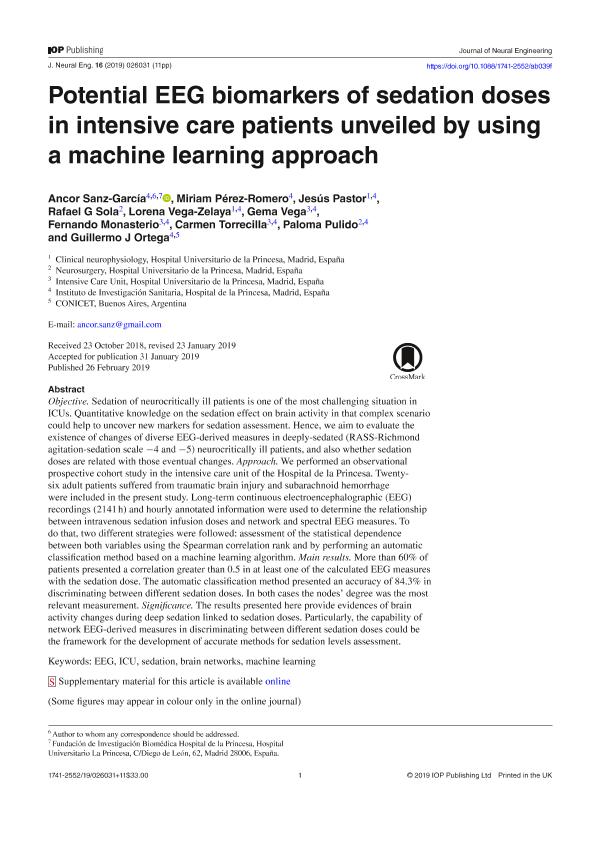Artículo
Potential EEG biomarkers of sedation doses in intensive care patients unveiled by using a machine learning approach
Sanz García, Ancor; Pérez Romero, Miriam; Pastor, Jesús; Sola, Rafael G.; Vega Zelaya, Lorena; Vega, Gema; Monasterio, Fernando; Torrecilla, Carmen; Pulido, Paloma; Ortega, Guillermo José

Fecha de publicación:
04/2019
Editorial:
IOP Publishing
Revista:
Journal of Neural Engineering
ISSN:
1741-2560
Idioma:
Inglés
Tipo de recurso:
Artículo publicado
Clasificación temática:
Resumen
Objective. Sedation of neurocritically ill patients is one of the most challenging situation in ICUs. Quantitative knowledge on the sedation effect on brain activity in that complex scenario could help to uncover new markers for sedation assessment. Hence, we aim to evaluate the existence of changes of diverse EEG-derived measures in deeply-sedated (RASS-Richmond agitation-sedation scale -4 and -5) neurocritically ill patients, and also whether sedation doses are related with those eventual changes. Approach. We performed an observational prospective cohort study in the intensive care unit of the Hospital de la Princesa. Twenty-six adult patients suffered from traumatic brain injury and subarachnoid hemorrhage were included in the present study. Long-term continuous electroencephalographic (EEG) recordings (2141 h) and hourly annotated information were used to determine the relationship between intravenous sedation infusion doses and network and spectral EEG measures. To do that, two different strategies were followed: assessment of the statistical dependence between both variables using the Spearman correlation rank and by performing an automatic classification method based on a machine learning algorithm. Main results. More than 60% of patients presented a correlation greater than 0.5 in at least one of the calculated EEG measures with the sedation dose. The automatic classification method presented an accuracy of 84.3% in discriminating between different sedation doses. In both cases the nodes' degree was the most relevant measurement. Significance. The results presented here provide evidences of brain activity changes during deep sedation linked to sedation doses. Particularly, the capability of network EEG-derived measures in discriminating between different sedation doses could be the framework for the development of accurate methods for sedation levels assessment.
Palabras clave:
BRAIN NETWORKS
,
EEG
,
ICU
,
MACHINE LEARNING
,
SEDATION
Archivos asociados
Licencia
Identificadores
Colecciones
Articulos(SEDE CENTRAL)
Articulos de SEDE CENTRAL
Articulos de SEDE CENTRAL
Citación
Sanz García, Ancor; Pérez Romero, Miriam; Pastor, Jesús; Sola, Rafael G.; Vega Zelaya, Lorena; et al.; Potential EEG biomarkers of sedation doses in intensive care patients unveiled by using a machine learning approach; IOP Publishing; Journal of Neural Engineering; 16; 2; 4-2019; 1-11
Compartir
Altmétricas



